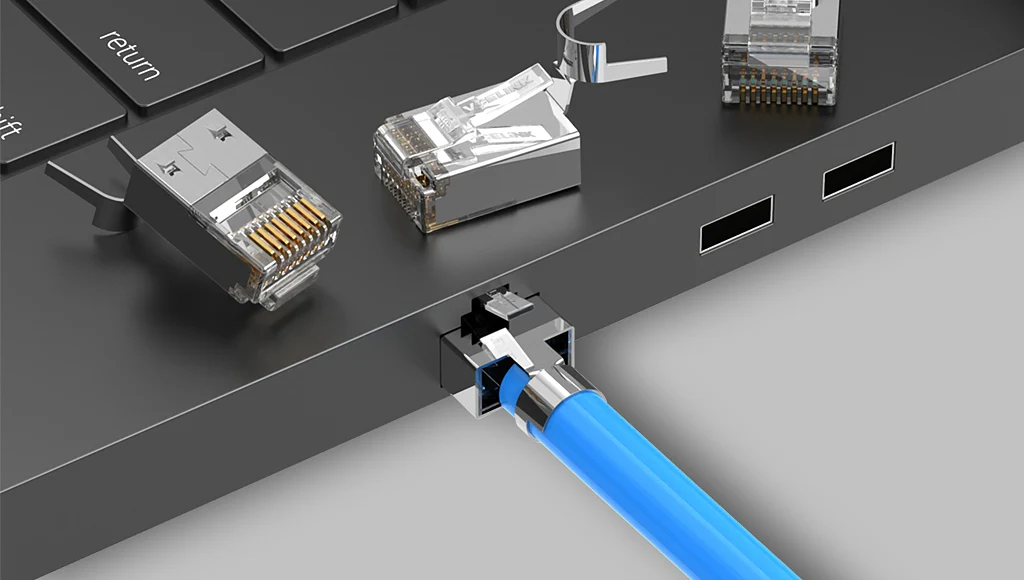DIMUD: Effective Management of RJ45 Connectors in Large-Scale Systems
At DIMUD, we understand that in today’s interconnected world, RJ45 connectors are vital components of network infrastructure. For small and medium-sized enterprises (SMEs), managing these connectors effectively within large-scale systems is crucial for ensuring network performance, reliability, and scalability. Below is our comprehensive guide to help you navigate the management of RJ45 connectors in extensive network setups.
1. Planning and Design
Effective management of RJ45 connectors begins with meticulous network planning and design. For large-scale systems, a structured network layout is paramount. Key considerations include:
-Network Layout: Create a detailed map of your network topology, including switches, routers, patch panels, and other devices. This blueprint will help determine the number of RJ45 connectors needed and their ideal placement.
-Cable Management: Establish a robust cable management system to handle the volume of network cables and connectors. Utilize cable trays, management panels, and labeling systems to maintain organization.
-Scalability: Design your network with future growth in mind. Reserve space for additional connectors and cables, and consider modular patch panels to simplify the addition of new connections.
2. Choosing the Right Connectors
Selecting high-quality RJ45 connectors is essential for optimal network performance. Important factors to consider include:
-Category Ratings: Ensure connectors match or exceed the category rating of your network cables (e.g., Cat5e, Cat6, Cat6a, Cat7) for faster data transfer and better shielding.
-Shielding: In high electromagnetic interference (EMI) environments, opt for shielded RJ45 connectors (STP or FTP) to maintain signal integrity.
-Quality: Invest in reliable connectors from reputable manufacturers to prevent issues such as poor connections and signal degradation.
3. Installation Best Practices
Proper installation techniques are vital for network reliability. Adhere to the following best practices:
-Termination Techniques: Use appropriate termination methods for your RJ45 connectors. Follow manufacturer instructions for crimping to ensure wires are properly seated and avoid connection issues.
-Testing: After installation, utilize a network cable tester to check each RJ45 connection for wiring faults, such as crossed or misaligned pins. This step helps identify problems before they impact network performance.
-Documentation: Maintain detailed records of your RJ45 connector installations. Document connector locations, associated devices, and specific configurations for easier troubleshooting and future upgrades.
4. Cable Management and Organization
Efficient cable management is crucial for large-scale systems to prevent tangling and wear:
-Cable Routing: Employ cable trays and raceways to organize cables neatly. Avoid sharp bends and excessive tension that could damage Ethernet cables and RJ45 connectors.
-Labeling: Clearly label each RJ45 connector and cable to indicate its purpose and destination, simplifying troubleshooting efforts.
-Patch Panels: Centralize connections using patch panels, which facilitate easier management and reconfiguration of network connections without disruption.
5. Maintenance and Monitoring
Regular maintenance and monitoring are essential for sustaining RJ45 connector performance:
-Routine Checks: Periodically inspect RJ45 connectors and cables for wear, damage, or loose connections. Address any issues promptly to avoid network downtime.
-Cleaning: Keep connectors and ports clean from dust and debris using compressed air or appropriate cleaning tools to ensure reliable connectivity.
-Firmware and Software Updates: Ensure that all network devices connected via RJ45 connectors are running the latest firmware and software to enhance performance and security.
6. Troubleshooting Common Issues
When connectivity issues arise, efficient troubleshooting is vital:
-Signal Problems: Check for common issues like loose connectors, damaged cables, or incorrect terminations if connectivity problems occur.
-Interference: In environments susceptible to EMI, ensure shielded RJ45 connectors are utilized and that cables are routed away from interference sources.
-Testing Equipment: Use network testing tools to diagnose issues related to signal quality or connectivity, helping identify wiring faults or other problems.
7. Training and Best Practices
Educating your team on best practices for managing RJ45 connectors is critical. Provide training on installation techniques, troubleshooting, and proper cable management to ensure a cohesive approach to network maintenance.
Conclusion
At DIMUD, we believe that managing RJ45 connectors in large-scale systems requires thoughtful planning, quality selection, precise installation, and ongoing maintenance. By following these guidelines, your organization can ensure a reliable, high-performance network that meets current needs and accommodates future growth. Effective management of RJ45 connectors not only enhances network reliability but also simplifies troubleshooting and maintenance, supporting a more efficient and resilient IT infrastructure.
To find products and services more accurately, please try entering keywords for search.
For more product and service content, please contact us and send an email to sales@dimud.com.
We sincerely look forward to connecting with you!


